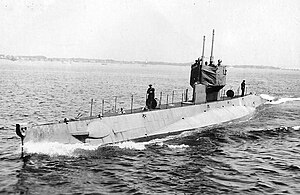USS L-9
 USS L-9. underway
| |
| History | |
|---|---|
| Name | USS L-9 |
| Builder | Fore River Shipbuilding Company, Quincy, Massachusetts |
| Laid down | 2 November 1914 |
| Launched | 27 October 1915 |
| Commissioned | 4 August 1916 |
| Decommissioned | 4 May 1923 |
| Stricken | 18 December 1930 |
| Fate | Scrapped, 28 November 1933 |
| General characteristics | |
| Class and type | L-class submarine |
| Displacement |
|
| Length | 168 ft 6 in (51.36 m) |
| Beam | 17 ft 5 in (5.31 m) |
| Draft | 13 ft 7 in (4.14 m) |
| Installed power |
|
| Propulsion |
|
| Speed |
|
| Range |
|
| Test depth | 200 feet (61.0 m) |
| Complement | 28 officers and enlisted men |
| Armament |
|
USS L-9 (SS-49) was an L-class submarine of the United States Navy.
Description[edit]
The L-class boats designed by Electric Boat (L-1 to L-4 and L-9 to L-11) were built to slightly different specifications from the other L boats, which were designed by Lake Torpedo Boat, and are sometimes considered a separate class. The Electric Boat submarines had a length of 168 feet 6 inches (51.4 m) overall, a beam of 17 feet 5 inches (5.3 m) and a mean draft of 13 feet 7 inches (4.1 m). They displaced 450 long tons (460 t) on the surface and 548 long tons (557 t) submerged. The L-class submarines had a crew of 28 officers and enlisted men. They had a diving depth of 200 feet (61.0 m).[1]
For surface running, the Electric Boat submarines were powered by two 450-brake-horsepower (336 kW) diesel engines, each driving one propeller shaft. When submerged each propeller was driven by a 170-horsepower (127 kW) electric motor. They could reach 14 knots (26 km/h; 16 mph) on the surface and 10.5 knots (19.4 km/h; 12.1 mph) underwater. On the surface, the boats had a range of 5,150 nautical miles (9,540 km; 5,930 mi) at 11 knots (20 km/h; 13 mph)[1] and 150 nmi (280 km; 170 mi) at 5 knots (9.3 km/h; 5.8 mph) submerged.[2]
The boats were armed with four 18-inch (450 mm) torpedo tubes in the bow. They carried four reloads, for a total of eight torpedoes. The Electric Boat submarines were initially not fitted with a deck gun; a single 3"/50 caliber gun on a disappearing mount was added during the war.[2]
Construction and career[edit]
L-9's keel was laid down on 2 November 1914 by Fore River Shipbuilding Company in Quincy, Massachusetts. She was launched on 27 October 1915 sponsored by Miss Heather Pattison Baxter, and commissioned on 4 August 1916. Assigned to the Atlantic Submarine flotilla, L-9 operated along the Atlantic coast until April 1917 developing new techniques of undersea warfare.
Following the United States's entry into World War I, submarines were needed to protect Allied shipping lanes to Europe. After an extensive overhaul, preparing her for the task ahead, L-9 departed Portsmouth, Virginia, on 17 January 1918 and arrived Bantry Bay, Ireland, on 21 February. She remained in British waters throughout the war, patrolling for U-boats.
After the Armistice with Germany on 11 November, L-9 operated out of the Isle of Portland, England, until she sailed 3 January 1919 for the United States. Arriving Philadelphia, Pennsylvania, on 1 February, the submarine operated along the Atlantic coast for the next four years developing submarine warfare tactics. L-9 decommissioned at Hampton Roads, Virginia, on 4 May 1923 and was scrapped on 28 November 1933.
Notes[edit]
References[edit]
- Friedman, Norman (1995). U.S. Submarines Through 1945: An Illustrated Design History. Annapolis, Maryland: Naval Institute Press. ISBN 1-55750-263-3.
- Gardiner, Robert & Gray, Randal, eds. (1985). Conway's All the World's Fighting Ships 1906–1921. Annapolis, Maryland: Naval Institute Press. ISBN 0-85177-245-5.
- This article incorporates text from the public domain Dictionary of American Naval Fighting Ships. The entry can be found here.
External links[edit]
- Photo gallery of USS L-9 at NavSource Naval History
